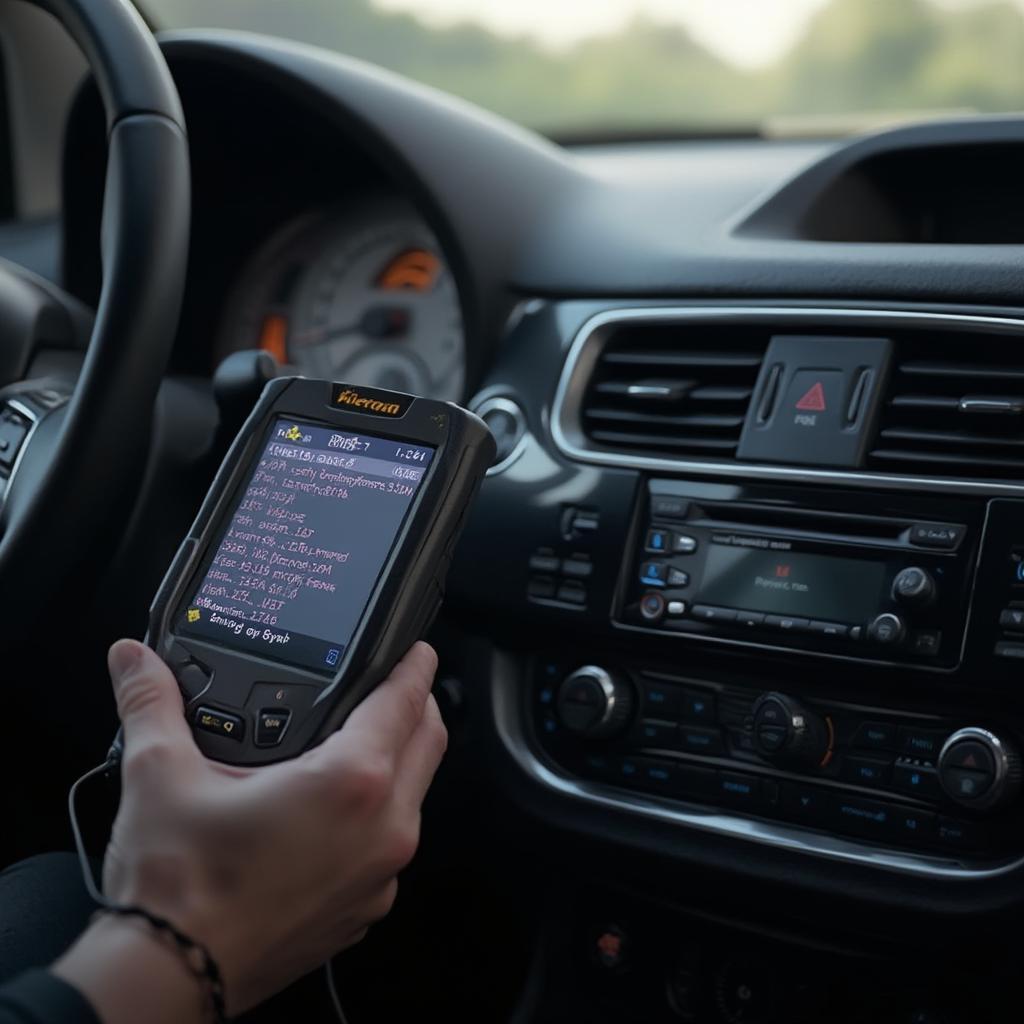OBD2 Fiat code keys are essential for deciphering the cryptic messages your Fiat might be sending. These codes, appearing as a string of letters and numbers, are like your car’s way of telling you something’s not quite right. Understanding these codes can empower you to address car issues head-on, saving you potential headaches and costly mechanic bills down the road.
 Fiat OBD2 Scanner Connected
Fiat OBD2 Scanner Connected
What are OBD2 Fiat Code Keys?
OBD2, short for On-Board Diagnostics, is a standardized system found in vehicles manufactured since 1996. When your Fiat’s onboard computer detects an issue, it generates a specific code stored in its memory. These codes, also known as Diagnostic Trouble Codes (DTCs), act as clues, pointing to the potential source of the problem.
Why are OBD2 Fiat Code Keys Important?
Imagine this: your “Check Engine” light illuminates. Instead of a vague warning, OBD2 Fiat code keys provide a specific starting point for diagnosis. This empowers you to:
- Identify the problem: Pinpoint the system or component experiencing issues.
- Save time and money: Avoid unnecessary repairs by focusing on the root cause.
- Communicate effectively with mechanics: Provide accurate information for quicker and more efficient repairs.
- Monitor your car’s health: Catch potential problems early before they escalate.
How to Read OBD2 Fiat Code Keys
Each OBD2 code follows a standardized format:
- The first character: Indicates the system affected (e.g., “P” for Powertrain, “B” for Body, “C” for Chassis, “U” for Network).
- The second character: Refers to whether the code is generic (“0”) or manufacturer-specific (“1”).
- The third character: Specifies the subsystem within the broader system (e.g., “1” for Fuel and Air Metering, “2” for Fuel and Air Metering – Injector Circuit).
- The last two characters: Identify the specific problem within the subsystem.
For instance, a code “P0171” translates to:
- P: Powertrain
- 0: Generic code
- 1: Fuel and Air Metering
- 71: System Too Lean (Bank 1)
Using an OBD2 Scanner with Your Fiat
An OBD2 scanner is a handheld device that connects to your Fiat’s OBD2 port, usually located under the dashboard on the driver’s side. Once connected, the scanner can:
- Read and display stored codes: Retrieve the OBD2 Fiat code keys triggering the “Check Engine” light.
- Clear codes: After repairs, erase the codes and turn off the warning light.
- Display live data: Monitor real-time engine parameters like speed, temperature, and oxygen sensor readings.
Common OBD2 Fiat Code Keys and Their Meanings
While numerous codes exist, some frequently encountered ones in Fiats include:
- P0420: Catalyst System Efficiency Below Threshold (Bank 1) – Potentially indicating a faulty catalytic converter.
- P0171: System Too Lean (Bank 1) – Suggesting insufficient fuel or excess air in the engine.
- P0300: Random/Multiple Cylinder Misfire Detected – Signaling potential issues with spark plugs, ignition coils, or fuel injectors.
- U0100: Lost Communication with ECM/PCM – Indicating a potential problem with the engine control module’s communication.
Expert Insights
“Don’t underestimate the power of OBD2 Fiat code keys,” advises John Miller, a seasoned Fiat mechanic with over 20 years of experience. “They are your starting point for effective troubleshooting. By understanding these codes, you can work with your mechanic more effectively and potentially save yourself from unnecessary expenses.”
Conclusion
OBD2 Fiat code keys are invaluable tools for car owners. Understanding these codes empowers you with the knowledge to address car problems proactively. By utilizing an OBD2 scanner and deciphering these codes, you can become a more informed and empowered Fiat owner.
